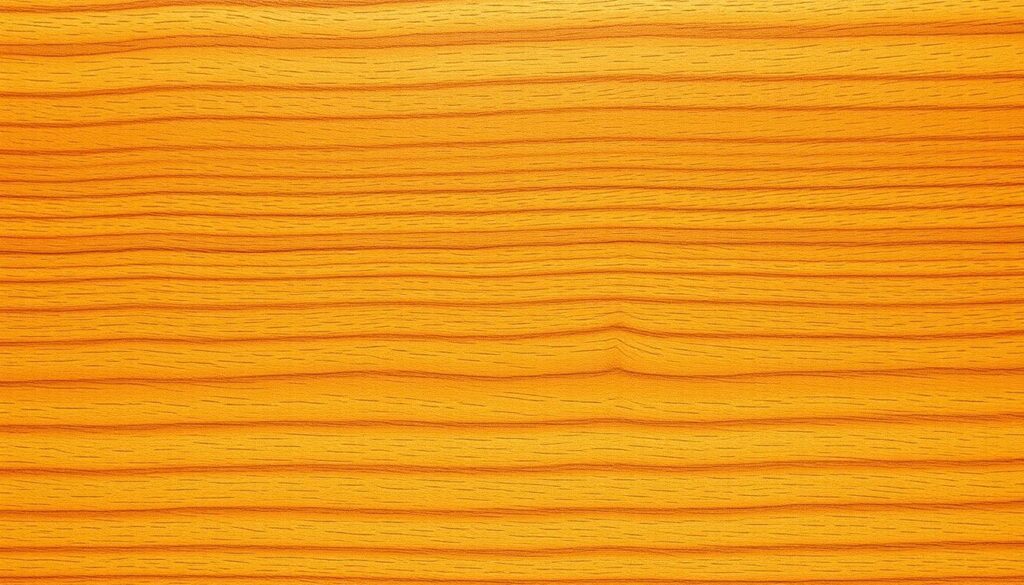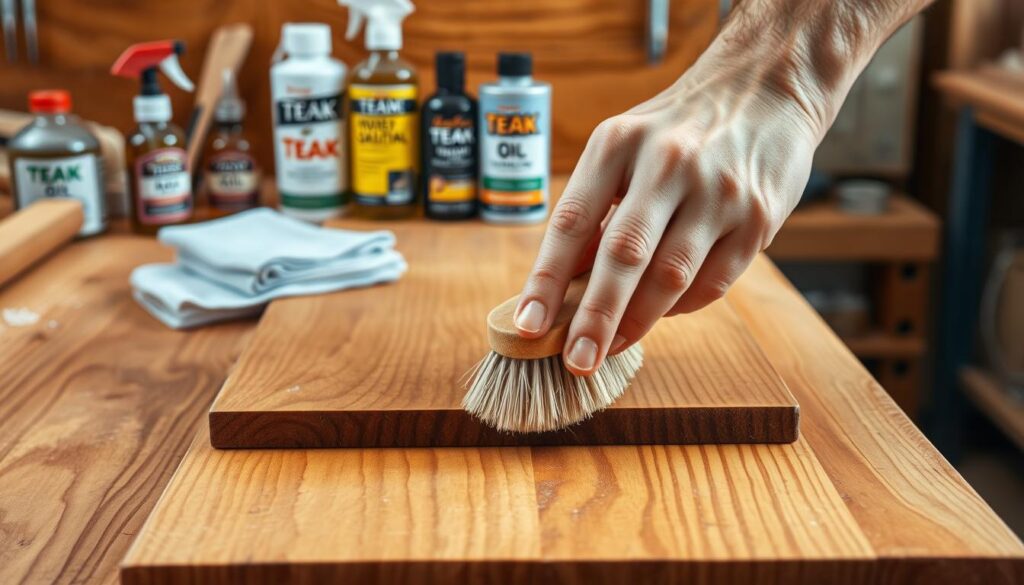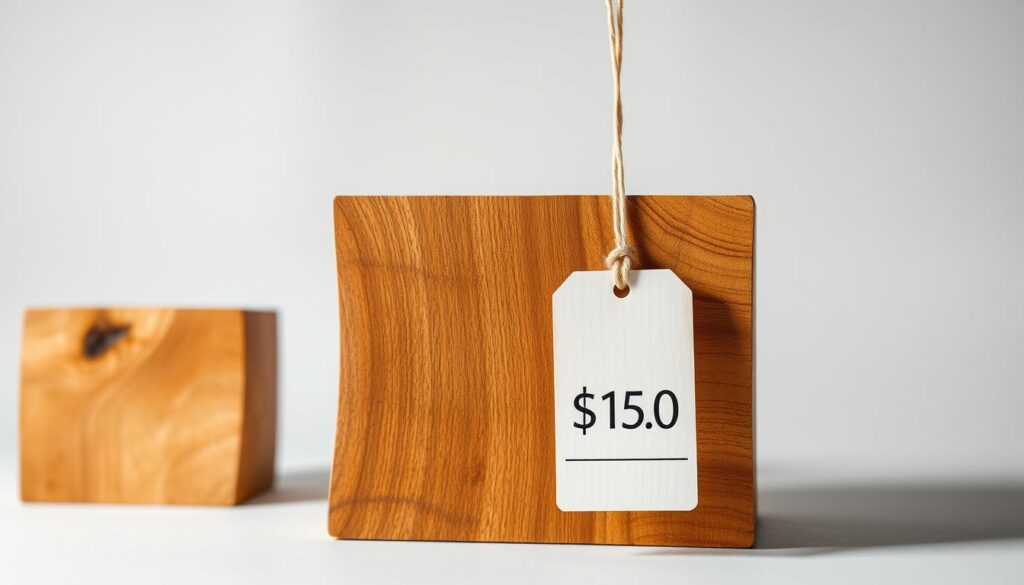Understand the impressive hardness and resilience of teak wood, a top choice for long-lasting outdoor furniture and structures.
Teak wood is highly valued for its durability and resistance to harsh weather. It’s a top choice for outdoor furniture and construction. Its high oil content and dense grain structure make it durable.

The hardness of teak wood helps it withstand extreme temperatures, moisture, and insects. This makes it perfect for many uses. Knowing about teak wood hardness helps people choose the right products for their needs.
Introduction to Teak Wood
Teak wood is prized for its high density and oil content. Its unmatched durability is due to its hardness. This makes it ideal for construction and furniture-making.
Key Takeaways
- Teak wood hardness is a critical factor in determining the durability of teak wood products
- Teak wood properties, such as its chemical composition and growth patterns, contribute to its remarkable durability
- Understanding teak wood hardness is essential for selecting the right teak wood products for specific applications
- Teak wood is a highly valued material for its exceptional durability and resistance to harsh weather conditions
- The durability of teak is largely attributed to its unique teak wood properties
- Teak wood hardness is a key factor in its ability to withstand extreme temperatures and moisture
Understanding Teak Wood’s Natural Properties
Teak wood is made up of many organic compounds. These include cellulose, hemicellulose, and lignin. This mix makes teak very durable and resistant to rot. The natural oils in teak, like silica and rubber, help protect it from bugs and moisture.
How teak wood grows also matters. Teak trees grow slowly, making the wood dense and hard. This slow growth leads to a straight grain and coarse texture. These features make teak great for many uses.
- Climate and soil conditions
- Tree age and growth rate
- Harvesting and processing methods
Knowing about teak wood’s natural properties is key. It helps us see why it’s so durable and versatile. By understanding teak wood’s unique traits, we can make the most of it. This way, we can create top-notch products that highlight its amazing qualities.
| Property | Description |
|---|---|
| Teak wood composition | Complex blend of organic compounds |
| Natural oils in teak | Protect the wood from insect damage and moisture |
| Teak wood growth patterns | Impact the wood’s formation and quality |
Measuring Teak Wood Hardness
Teak wood is known for its amazing durability. Measuring its hardness is key to understanding its strength. The Janka hardness scale is a common method used to check the hardness of wood, including teak. It shows how well wood can resist denting and wear.
Teak wood is very hard compared to other hardwoods. It has a Janka hardness rating of 1,070 pounds per square inch (psi). This high rating comes from its special chemical makeup and growth patterns, making it very dense and durable.
Janka Hardness Scale Rating
The Janka hardness scale rating is important for choosing teak wood. Teak wood testing methods, like the Janka test, give us important information about its hardness. By comparing teak wood’s rating to other hardwoods, we can decide its best uses.
Comparison to Other Hardwoods
Teak wood is much harder and more durable than many other hardwoods. Here’s a table showing the Janka hardness scale ratings of different hardwoods:
| Wood Species | Janka Hardness Scale Rating (psi) |
|---|---|
| Teak | 1,070 |
| Oak | 1,290 |
| Maple | 950 |
| Cherry | 995 |
Scientific Testing Methods
Scientific tests, like the Janka test, are vital for checking teak wood’s hardness and durability. These tests help us see how well teak wood works in different uses, from furniture to building. Knowing the test results helps us choose the right products made from teak wood.
Environmental Factors Affecting Teak Durability
Teak wood is known for its long-lasting quality. But, environmental factors can change how long it lasts. Sunlight, moisture, and extreme temperatures can all play a role. It’s important to know how these factors affect teak wood to keep it in good shape.
Teak wood faces challenges when it’s outside. UV rays, rain, and extreme weather can cause damage. To keep it safe, applying protective treatments and regular care is key. Here are some ways to protect your teak wood:
- Applying a waterproof sealant to prevent moisture damage
- Using a UV-resistant finish to protect against sunlight
- Regularly cleaning and inspecting the wood to prevent damage
By understanding the environmental factors that impact teak wood durability, you can take steps to protect it. This way, your teak wood can handle different outdoor conditions and last for many years.
Commercial Applications Based on Teak’s Hardness
Teak wood is very hard and durable, making it perfect for many commercial uses. It’s especially good for marine construction because it can handle tough sea conditions. It’s used to build boats, ships, and other sea vessels.
Teak wood is also great for outdoor furniture materials. It doesn’t rot, decay, or get damaged by insects, which is perfect for outdoor furniture. This makes it a favorite for making benches, tables, and chairs that can last a long time.
Key Applications of Teak Wood
- Marine construction: boat building, shipbuilding, and other marine vessels
- Outdoor furniture: benches, tables, chairs, and other outdoor furniture pieces
- Construction uses: building frames, doors, and windows
Teak wood is versatile and valuable in many ways. Its hardness and durability make it a top choice for teak wood applications. This includes marine construction and outdoor furniture materials. So, teak wood is highly sought after in the construction and manufacturing fields.
Video source from youtube
| Application | Benefits |
|---|---|
| Marine Construction | Withstands harsh marine environments, durable, and low maintenance |
| Outdoor Furniture | Natural resistance to rot, decay, and insect damage, durable, and low maintenance |
| Construction Uses | Durable, resistant to warping, and can withstand heavy loads |
Teak Wood’s Resistance Properties
Teak wood is famous for its amazing ability to resist decay, insects, and other damage. This makes it perfect for both outdoor and indoor use. Its high oil content acts as a natural shield, keeping it safe from rot and bugs.
Teak wood can handle tough weather, like rain and sun, thanks to its natural oils and resins. These protect it from harmful fungi and bacteria. It also keeps insects away, like borers and termites, thanks to special compounds.
Some of the key benefits of teak wood’s resistance properties include:
- Long-lasting durability, with a lifespan of up to 50 years or more
- Low maintenance requirements, as it can withstand harsh weather conditions
- Resistance to insect damage, reducing the need for chemical treatments
- Natural beauty, with a distinctive grain pattern and rich color
Teak wood’s unique mix of natural properties makes it great for many uses. From outdoor furniture to building and boats, it’s a top choice. Its durability, beauty, and easy care make it a favorite among builders, designers, and homeowners.
Maintaining Teak Wood’s Natural Hardness
Teak wood is known for its durability and beauty. To keep it looking great, you need to maintain it regularly. This includes cleaning, applying protective treatments, and regular care. By following these steps, your teak wood will stay beautiful for many years.
Cleaning your teak wood regularly is key. Use a gentle cleaner and a soft brush to remove dirt. Then, rinse it with clean water. For tough stains, mix equal parts water and white vinegar.
Cleaning Techniques
- Use a gentle cleaner and a soft brush to clean the wood
- Rinse with clean water to remove any soap residue
- Use a solution of equal parts water and white vinegar for stubborn stains
Protective Treatments
Applying protective treatments is also important. These treatments help protect your teak wood from moisture and UV rays. You can use a waterproof sealant or teak oil for this purpose.

Regular Maintenance Schedule
Creating a regular maintenance routine is crucial. This includes cleaning, applying treatments, and checking for damage. By doing this, your teak wood will always look its best.
Geographic Sources and Quality Variations
Teak wood comes from different places, affecting its quality. There are two main types: old-growth teak and plantation teak. Old-growth teak comes from natural forests, while plantation teak is grown on farms.
The quality of teak wood varies. Old-growth teak is often better because it grows slower. This makes the wood denser and harder. Plantation teak is cheaper and easier to find, but it’s not as good as old-growth teak.
Regional Differences in Teak Wood Quality
Where teak wood comes from also matters. Teak from Southeast Asia is often better because of the climate and soil. Here’s a table showing some quality differences by region:
| Region | Teak Wood Quality | Characteristics |
|---|---|---|
| Southeast Asia | High | Dense, hard, and resistant to rot and insect damage |
| Africa | Medium | Less dense and harder than Southeast Asian teak, but still durable |
| Central America | Low | Softer and more prone to rot and insect damage |
When picking teak wood, think about where it comes from and its quality. Whether you want old-growth or plantation teak, knowing about sources and quality helps you choose well.
Cost Implications of Teak’s Durability
Teak wood’s cost is a big factor to think about. It might cost more than other woods at first. But, its durability and cost make it a smart choice in the long run.
Teak wood doesn’t rot, decay, or get damaged by insects easily. This means it needs less upkeep and won’t need to be replaced often. So, you save money over time.
Some key benefits of teak wood’s durability include:
- It needs little maintenance, so you won’t have to fix or replace it often.
- It stands up well to moisture and extreme temperatures.
- With the right care, teak wood can last for decades.
When looking at teak wood’s cost, remember its durability and value. Although it costs more upfront, the long-term savings and benefits are worth it. Teak wood’s durability is a big plus, offering a natural and lasting solution for many uses.
Here’s a comparison of different wood costs:
| Type of Wood | Initial Cost | Long-term Savings |
|---|---|---|
| Teak Wood | Higher | High |
| Other Hardwoods | Lower | Lower |

In conclusion, teak wood’s durability has big cost benefits. It offers long-term savings and advantages, making it a smart choice. By thinking about teak wood’s durability and cost, you can make a good decision. And enjoy the benefits of this sustainable and natural material.
Sustainable Harvesting and Future Availability
As teak wood demand grows, we must focus on sustainable harvesting. This ensures teak remains available for the future. Conservation efforts, like reforestation and responsible forestry, are key to protecting teak forests.
Some key strategies for sustainable teak harvesting include:
- Selective logging, which involves harvesting only mature trees to minimize the impact on the forest ecosystem
- Reforestation efforts, which help to replenish teak forests and maintain their biodiversity
- Certification programs, which promote responsible forestry practices and provide a guarantee of sustainability
The future of teak wood depends on balancing demand with conservation. Supporting sustainable harvesting and conservation ensures teak wood’s long-term availability. This preserves vital ecosystems for future generations.
Market projections show teak wood demand will keep growing. Its popularity in construction and furniture drives this. By focusing on sustainable harvesting and conservation, we can keep teak wood available for years to come.
| Year | Teak Wood Demand | Sustainable Harvesting Practices |
|---|---|---|
| 2023 | 10,000 cubic meters | Selective logging, reforestation efforts |
| 2025 | 12,000 cubic meters | Certification programs, responsible forestry management |
| 2030 | 15,000 cubic meters | Expanded reforestation efforts, increased certification |
Conclusion: The Enduring Value of Teak Wood
Teak wood is truly remarkable because of its hardness and durability. Teak wood’s value goes beyond its looks. It’s also cost-effective and sustainable in the long run.
Teak wood stands up well to weather and pests. It also needs little care. This makes it a top choice among natural materials.
Teak wood is great for many uses. It’s perfect for luxury yachts, outdoor furniture, and high-end homes. The benefits of teak wood are clear. It’s a smart investment that lasts for decades.
FAQ
What is the Janka Hardness Scale?
The Janka Hardness Scale measures wood hardness. It shows how much force is needed to embed a steel ball halfway into the wood. This scale helps compare the hardness of different woods, like teak.
How does teak wood compare to other hardwoods in terms of hardness?
Teak wood is very hard and durable. On the Janka Hardness Scale, it scores between 1,000 and 1,200 pounds-force. This makes it harder than many other hardwoods, like oak and maple.
What environmental factors affect the durability of teak wood?
Several things can affect teak wood’s durability. Sunlight, moisture, and extreme temperatures are key factors. UV rays can cause fading, while too much moisture can lead to decay. Keeping teak wood treated and maintained is important to preserve its hardness.
What are the key commercial applications of teak wood based on its hardness?
Teak wood’s hardness makes it great for many uses. It’s often used for boat decking, outdoor furniture, and high-end interior projects. Its durability is a big reason why it’s so popular.
How does the source and quality of teak wood affect its hardness?
Teak wood’s hardness can vary based on where it comes from. Old-growth teak is generally harder and of higher quality than plantation-grown teak. The wood’s density and hardness can also be influenced by the local soil and climate.
What are the cost implications of teak’s durability?
Teak wood might cost more upfront than other hardwoods. But its durability means it lasts longer and needs less maintenance. This can save money in the long run because it doesn’t need to be replaced as often.
What are the efforts to ensure the sustainable harvesting and future availability of teak wood?
There are efforts to harvest teak wood sustainably. This includes replanting and managing teak plantations. It also involves finding eco-friendly ways to process teak. These steps help ensure teak wood remains available while protecting the environment.
Read also : Teak Wood Tree: Exploring Its Unique Features
